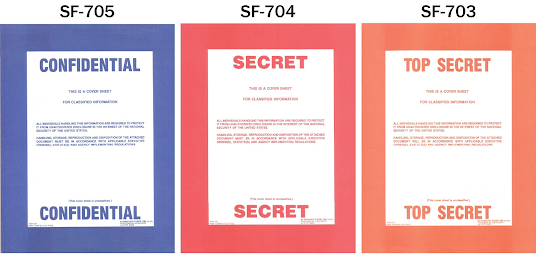During my military career as an Army artillery officer, I used and handled some of the highest-classified, most restricted-access documents and materials in the defense department, including on staff of Headquarters, XVIII Airborne Corps, and the Pentagon. I had for many years a TS/SCI clearance and I originated documents that were classified up to Top Secret. I also served as a nuclear target analyst and handled and decrypted Nuclear Control Orders. So, I would like to offer clarification on what the classifications are and what they mean.
You may from time to time hear someone says that something is classified "above Top Secret" or words to that effect. No. The three classifications of Confidential, Secret, and Top Secret are nothing at all but labels to determine how securely the material must be locked up, whether physically or electronically. Basically, think of it this way: Confidential documents must be locked up (when not in use) in a safe that would take at least, say, 10 minutes to break into, Secret 20 minutes, and Top Secret 30 minutes.
That is all those classifications mean in themselves. There is no such thing as "above Top Secret" because what would be the point? TS is already the most secure that is reasonably attainable. That said, it is obvious that the more sensitive the document or material being classified, the more protection against unauthorized access it gets, hence the higher its classification.
TS materials often (even usually) have codewords attached to them that are used to control who has access to them. I had a TS clearance, but that did not mean that I could access anything classified TS. If I had no part in Operation Dismal Swamp, for example, I was denied access to classified materials relating to it, TS clearance or not. That practice is probably what people mean when they say, "above Top Secret." But actually, all classified materials are restricted to people who have a need to know.
Furthermore, one excuse made for Donald Trump's possession of classified documents is that as president he could declassify any document he wanted to. That is incorrect. By federal law, there is an entire category of classified material, called Restricted Data or Formerly Restricted Data, that cannot be declassified unilaterally by any one person. There is a process that must be followed, with multi-department and multi-agency inclusion. This process and who must be included (by the office that they hold) are precisely defined in the law. These secrets include those that are not originated by the Department of Defense, and that is why the president’s Constitutional authority as commander in chief of the armed forces does not give him unilateral authority on that category of national secrets. In fact, the president has no role at all in the defined process except as a tie-breaker if the others' decision/votes are tied.
As for a president's authority to declassify anything else, that is true. But there is still a process that must be followed. Just taking them somewhere does not do it. Even for a president, there are steps that must be followed and proper procedures that must be done. Records of the declassification must be made. The president cannot declassify simply by thinking about it. Nor does merely carrying classified documents in his or an aide’s briefcase do it. "It is in my possession and therefore is unclassified it I want it to be" does not declassify anything. Again: even for a president, there are steps that must be followed and records of the action that must be made.
Vice presidents, of course, have exactly zero authority in any of these matters.
Update - What is a SCIF?

